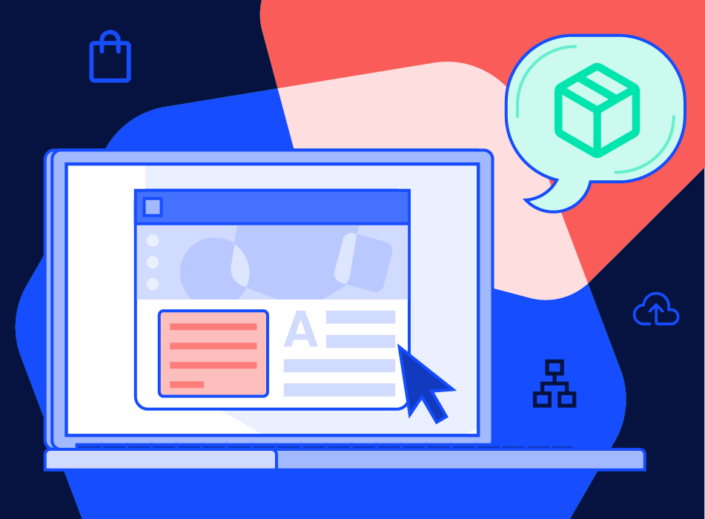As an ecommerce brand, it can be discouraging to see lots of website traffic but few sales. But this doesn’t mean your business is a failure—it’s simply a sign that you need to tweak your site’s content or performance to better align with customer expectations.
Wondering how to increase conversion rates? You’re in the right place. It all starts with evaluating the experience visitors have on your website, determining how this affects conversions, and making targeted changes to improve things.
How to increase conversion rate
The median ecommerce conversion rate is 4.2%. Your conversion rate might be lower or higher, but whatever the case, your goal should always be to increase the number of site visitors that turn into paying customers.
Below, we cover 15 strategies you can use to understand and optimize your website’s user experience (UX) and conversion rate. They’re grouped into four main categories:
- Tracking and testing
- Website content
- The checkout process
- Website performance
Tracking and testing
If your conversion rate is lower than you’d like, resist the temptation to immediately change your homepage headline or make your CTA buttons bigger.
Instead, start by analyzing your website data, learning where people tend to drop out of your conversion funnel, and setting up A/B tests for optimization adjustments.
1. Analyze website visitor data
Before you can improve your conversion rate, you need to understand what’s happening on your site right now. The more clearly you can see how people interact with your site, the easier it is to spot what’s working and what’s not.
Start by determining where your traffic is coming from: paid ads, organic search, social media, email campaigns, or other sources. This will help you figure out which channels are actually driving sales and which are simply attracting casual browsers.
Next, pay close attention to how users behave once they’re on your site:
- Which pages are they visiting most?
- How much time are they spending there?
- What percentage of customers make more than one purchase?
- How much do customers spend on average?
The goal here isn’t just to collect data—it’s to find customer behavior patterns that help you make smarter decisions. Once you’ve identified these patterns, you’re ready to analyze your conversion funnel and determine friction points.
2. Assess your conversion funnel
Now that you understand how visitors are interacting with your site, it’s time to figure out where you’re losing them.
Your conversion funnel maps out each stage a customer goes through, from landing on your site to completing a purchase. When assessing your conversion funnel, start by identifying your biggest drop-off points. It’s common to see a sharp decline at checkout, especially if the process is long or confusing. But drop-offs can happen anywhere: product pages, cart pages, even right after landing on your homepage.
If a high percentage of visitors leave without taking any action, it’s a sign that something’s off.
Next, look at which pages perform best. Are certain product pages converting at a much higher rate than others? Do some landing pages have unusually low engagement? Dig into why.
If you’re struggling to uncover friction points, consider using heatmap software. Heatmaps reveal where people click, how far they scroll, and where they get stuck. For example, if a heatmap shows that users are constantly hovering over an element that doesn’t do anything, it’s a sign you might need to rework the page layout.
3. Conduct A/B testing
When it comes to increasing conversion rates, guessing won’t get you very far. A/B testing gives you real data on what actually works by comparing two versions of a page element—like a headline or button—to see which performs better.
Instead of overhauling everything at once, focus on one element at a time. The following areas are worth testing:
- Headlines
- Photos and interactive elements
- Call to action (CTA) buttons
- Placement of reviews
- Product descriptions
- Navigation structure
- Promo messaging
- Trust badges
Not every test will lead to a big win, and that’s okay. Your goal is to build a habit of testing, learning, and adjusting based on customer behavior.
4. Survey customers
As valuable as hard data is, sometimes the best way to understand why people buy—or don’t—is to just ask. Try sending a quick post-purchase survey to learn what customers value most about your product, what convinced them to buy, or what nearly held them back. Their responses can highlight your strongest selling points and guide future improvements.
Website content
Your website’s content—copy, images, layout, and more—plays a huge role in whether visitors make a purchase or move on.
The following ideas will help ensure that visitors understand the value your products offer, find exactly what they need, and have the confidence to move forward with a purchase.
5. Include social proof
Social proof builds trust fast, especially for people who haven’t bought from you before. In fact, 77% of shoppers specifically seek out websites with ratings and reviews, and 90% consider reviews when making a purchase decision.
While star ratings are great, you can increase the impact of your social proof by taking things a step further:
- Allow buyers to leave written reviews that mention specific use cases or results.
- Use images or videos from happy customers to make the experience feel more real.
- Highlight testimonials on product pages, in emails, or near checkout to reassure shoppers at key moments.
When it comes to social proof, authenticity and visibility are key. If potential customers see that real people use (and love) your products, they’ll feel more confident making a purchase.
6. Write strong CTAs
Your calls to action (CTAs) are some of the most important elements on the page, and they should be clear, visible, and convincing. When crafting CTAs, keep these best practices in mind:
- Be specific. Instead of a generic “Click Here,” use action-oriented phrases like “Get My Discount” or “See Sizing Info.”
- Focus on benefits. Highlight what the shopper gets out of the click—not just what they’re doing.
- Use contrast and placement. Your CTA button should stand out visually and be easy to find, especially on mobile.
- Test variations. Even small wording or color changes can impact conversions, so run A/B tests to see what gets the most clicks.
Bottom line? If you want people to take action, don’t bury the ask. Make it obvious, compelling, and easy to act on.
7. Communicate your main value proposition
Every ecommerce site needs to answer one big question: Why should someone buy from you instead of a competitor? That’s your value proposition. And if it’s buried, vague, or missing, you’re leaving conversions on the table.
If you’ve already analyzed your site data and surveyed customers, you should have a good sense of what’s driving purchases.
Whether it’s your pricing, shipping, returns policy, a standout product feature, or something else, that core value proposition needs to be front and center.
Communicate it clearly by doing the following:
- Lead with it. Your homepage, product pages, and even ad copy should make your value proposition obvious within a few seconds.
- Use customer language. Pull phrases from surveys or reviews to describe what makes your product great. Chances are, your next customer will relate!
- Back it up. Use visuals, testimonials, or data points to reinforce your claim.
Before we move on, a word of caution: with ecommerce websites, simplicity is your best friend. One study shows that ecommerce pages written at a 5th to 7th-grade reading level have the highest conversion rates, while more complex sites see fewer sales.
So when communicating your value proposition, remember to keep things easy to read and straightforward—your conversion rate will thank you.
8. Make site navigation simple
A clean, intuitive site structure makes it easier for shoppers to explore, compare, and ultimately buy.
To get started, organize your navigation menu in a logical, consumer-friendly way. Group similar products together, use clear labels, and avoid overwhelming users with too many options at once.
In addition to an organized navigation menu, the following features will help shoppers find exactly what they’re looking for:
- Functional site search. Help shoppers find what they want with a fast, accurate search bar. (Bonus points if it includes autocomplete or filters.)
- Personalized recommendations. Use customer behavior or browsing history to suggest products they’re likely to be interested in.
- Best sellers or top categories. These can guide new visitors toward popular products if they’re not sure where to start.
9. Refine product pages
A good product page doesn’t just show what you’re selling; it answers questions, builds trust, and gives shoppers the confidence to click “Check Out.”
The best product pages have accurate descriptions, high-quality visuals, and plenty of reviews from real-life customers.
Let’s start with product descriptions—they should be accurate, easy to read, and focused on what your customers care about most. Highlight features, dimensions, materials, use cases, or care instructions. If sizing or fit is a concern, offer guidance to help reduce uncertainty (and returns).
Visuals matter just as much as descriptions, so make sure to include high-quality images from multiple angles. Videos are also a great way to show the product in use or highlight key details. If it makes sense for your brand, include interactive features like 360-degree views or virtual try-ons.
Customer reviews are the final piece of the puzzle; make sure to display them prominently to add credibility and help buyers make informed decisions.
The checkout process
Checkout can be the greatest stumbling block in the conversion funnel—or it can be a smooth experience that encourages buyers to complete their purchase.
Let’s look at three strategies to make the checkout experience smooth and hassle-free.
10. Offer fast, affordable shipping
Forty-one percent of global online shoppers have abandoned their carts because delivery costs were too high.
If you want to reduce friction in your checkout flow—and stop shoppers from taking their business elsewhere—offering fast and affordable (or even free) shipping is essential.
To keep shipping costs low for your customers, consider using a shipping API like EasyPost. With EasyPost, you can integrate with reliable carriers, easily compare rates, access steep rate discounts, and pass the cost savings on to your customers.
In addition to using technology to save money, make sure to be transparent about shipping costs early on to avoid surprising customers with extra fees during checkout.
It’s also helpful to offer a variety of shipping options so customers can choose the speed and price that works best for them.
11. Shorten your forms
Long, complicated forms can overwhelm customers and lead to cart abandonment. Shortening your checkout forms is a simple but powerful way to improve conversion rates.
When a customer makes it to the checkout page, only ask for essential information like their name, shipping address, and payment details. Anything beyond that is likely unnecessary at this stage. If you want to request more information (like a phone number), make it optional.
It’s also helpful to consolidate fields wherever you can. For example, instead of separate fields for address line 1 and address line 2, you might combine them into one field to reduce friction.
12. Offer a guest checkout option
Forcing customers to create an account before purchasing can be a major barrier. Some shoppers simply don’t want to commit to an account, especially if they’re in a rush or are only making a one-time purchase.
Offering a guest checkout option makes it easier for them to complete their order without unnecessary steps.
This doesn’t necessarily mean you shouldn’t encourage customers to create an account. Just make it optional, or even wait until after the sale.
13. Send abandoned cart emails
If someone adds items to their online cart—or even makes it to the checkout page—but leaves your website before finalizing their purchase, don’t despair! You still have an opportunity to convert these customers by sending abandoned cart emails.
These emails are powerful tools for driving sales, with the highest average revenue per recipient ($3.65) and order placed rate (3.33%) of all marketing email flows.
For best results, send an abandoned cart email within an hour of abandonment, while the potential purchase is still fresh in the shopper’s mind.
Include a reminder of what’s in their cart and a direct link to the checkout page, and try offering an incentive like a small discount or free shipping to seal the deal.
Website performance
Finally, let’s take a moment to talk about website performance. Are a few extra seconds of loading time really a big deal? Does it matter if your headline gets cut off when someone views your site on their phone? Yes and yes.
Technical elements like loading speed and mobile performance may seem insignificant, but they can make or break your conversion rate.
14. Improve your loading speed
If your site takes too long to load, users will likely lose patience and leave before completing their purchase. Even a one-second delay can lead to a significant drop in conversions.
If you want to keep visitors engaged and reduce bounce rates, optimizing your site’s speed isn’t optional—it’s necessary. These ideas will get you started:
- Compress images to reduce file sizes without sacrificing quality.
- Use browser caching to allow repeat visitors to load pages faster.
- Minimize HTTP requests by combining files.
- Optimize your code by removing unnecessary elements and minimizing HTML, CSS, and JavaScript.
By keeping your site fast and responsive, you’ll provide a smoother shopping experience and keep customers coming back.
15. Design for mobile
With more shoppers browsing and buying from mobile devices, the most successful brands design their sites with mobile users in mind.
You might be surprised to learn that the conversion rate for ecommerce sites is highest for tablet devices. If your website doesn’t look and work great on a tablet, think about how many sales you’ll miss out on!
To avoid losing customers, make sure your site is responsive and easy to navigate on a smartphone or tablet. Buttons should be easy to tap, text should be legible without zooming, and the checkout process should work just as smoothly on mobile as it does on desktop.
Make conversion optimization easy
If you’re seeing a low conversion rate—especially when it’s paired with high cart abandonment—your shipping may be the culprit.
When delivery costs too much or takes too long, many customers leave websites without finalizing their purchases. They know they can buy a similar product from a competitor and have it delivered for a few dollars less, or a few days sooner.
The best way to solve the problem? Manage your parcel shipping with the EasyPost Shipping API. EasyPost makes it simple to connect with carriers, rate shop, and access discounted rates. And with the added power of Luma, an AI-driven shipping tool, you can automatically identify inefficiencies and find the most cost-effective shipping labels.
When you save on shipping, your customers save on shipping—and that motivates them to click “Buy Now.”



